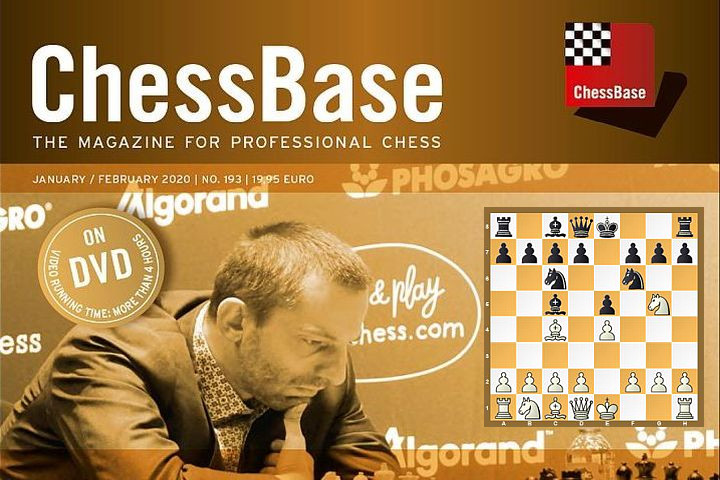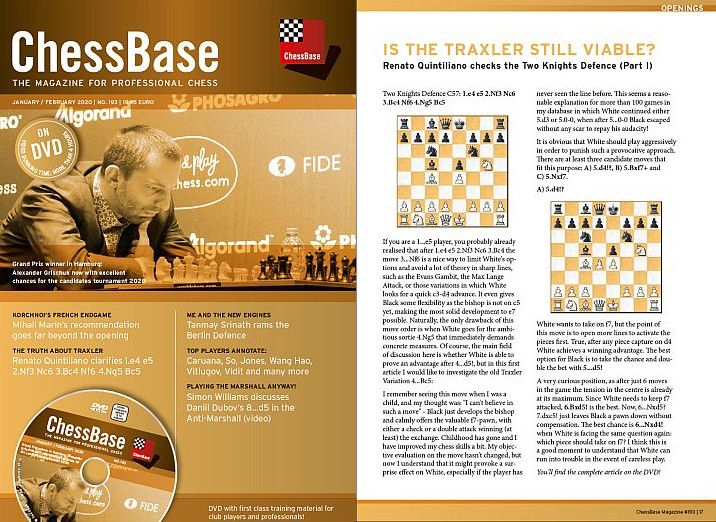


If you are a 1...e5 player, you probably already realized that after 1.e4 e5 2.♘f3 ♞c6 3.♗c4 the move 3...♞f6 is a nice way to limit White's options and avoid a lot of theory in sharp lines, such as the Evans Gambit, the Max Lange Attack, or those variations in which White looks for a quick c3-d4 advance. It even gives Black some flexibility as the bishop is not on c5 yet, making the most solid development to e7 possible. Naturally, the only drawback of this move order is when White goes for the ambitious sortie 4.♘g5 that immediately demands concrete measures. Of course, the main field of discussion here is whether White is able to prove an advantage after 4...d5!, but in this first article I would like to investigate the old Traxler Variation 4...♝c5:
I remember seeing this move when I was a child, and my thought was: "I can't believe in such a move" — Black just develops the bishop and calmly offers the valuable f7-pawn, with either a check or a double attack winning (at least) the exchange.
Childhood has gone and I have improved my chess skills a bit. My objective evaluation on the move hasn't changed, but now I understand that it might provoke a surprise effect on White, especially if the player has never seen the line before. This seems a reasonable explanation for more than 100 games in my database in which White continued either 5.d3 or 5.0-0, when after 5...0-0 Black escaped without any scar to repay his audacity!
It is obvious that White should play aggressively in order to punish such a provocative approach. There are at least three candidate moves that fit this purpose: A) 5.d4!?, B) 5.♗xf7+ and C) 5.♘xf7.
White wants to take on f7, but the point of this move is to open more lines to activate the pieces first.
True, after any piece capture on d4 White achieves a winning advantage. The best option for Black is to take the chance and double the bet with 5...d5!
A very curious position, as after just six moves in the game the tension in the centre is already at its maximum. Since White needs to keep f7 attacked, 6.♗xd5! is the best. Now, 6...♞xd5? 7.dxc5! just leaves Black a pawn down without compensation. The best chance is 6...♞xd4! when White is facing the same question again: which piece should take on f7?
I think this is a good moment to understand that White can face some practical problems in the event of careless play. The natural 7.♘xf7? ♛e7 8.♘xh8 leads to a position evaluated as 0.00 by the engine (never a good signal if you are a rook up!). The point is that after 8...♝g4! Black surprisingly gets enough compensation, as after ...0-0-0 the knight on h8 is likely lost and all his pieces are developed, with real chances of taking the initiative.
Instead, White can go for the safer continuation 7.♗xf7+ ♚e7 8.♗c4 with a pawn up. True, Black is able to pose some practical problems with moves like ...b5, ...h6, ...♝g4 and even ...♜f8. With correct play, White should be able to consolidate the advantage, but it requires some precision.
Although Black has lost the pawn, White is obliged to move the bishop again, which means lagging behind in development.
The absence of the f7-pawn may also be used in Black's favour, as the rook will be active on f8 and the idea ♕e8-g6(-h5) is a new possibility. Still, a pawn is a pawn, the Black king remains in the centre and White has no weaknesses in his camp, which should be enough to claim a clear advantage. After 6.♗b3 ♜f8 7.d3 d6 8.♗e3! White is doing nicely, exchanging the active ♗c5 and, more importantly, keeping the possibility of hiding the king on the queenside where it would be much safer against Black's ideas.
Now Black reveals the trick 5...♝xf2+!
Quite a curious picture! Both sides strike at their respective targets, although for Black it means sacrificing even more material. It is pretty clear that the second player is burning all the bridges very early, making the weight of White's decisions bigger. What should he do next?
What brings us to the next question: where should the king be placed? White's task is anything but easy here. The most played move is 7.♔g1, but Black keeps the threats after 7...♛h4! 8.g3 ♞xg3! The analysis of the old and curious game Pravda readers — Tal, M. (1969) prove that with correct play by both sides the result is a draw by perpetual check, although in the aforementioned encounter White took too many risks and was even lost.
7.♔e3! seems White's best chance to play for an advantage, but the continuation is similar: 7...♛h4! 8.g3 ♞xg3! 9.hxg3 ♛d4+ 10.♔f3 and now 10...d5! keeps White busy with threats.
White is two (!) pieces up, but it seems unlikely that he is able to keep such a big advantage with so many threats hanging over his head. Considering the risks.
Since there's no way back, Black keeps playing as actively as possible, going for quick development.
In view of the threat ...♝g4, White should play 8.exd5 ♞d4, with a still tense situation:
This position is anything but harmless for White, despite the big material advantage. For example, after the most played 9.c3 ♝g4! 10.♕a4+ ♞d7.
He is suddenly lost! As strange as it may look at first sight, there are too many threats against the king now — ....0-0-0, ...♛f6 or ...♛h4+ if the bishop is taken. White tried the last option in most of the games, but after 11.♔xf2 ♛h4+ Black's attack is unstoppable.
The correct 9th move for White is 9.d6!
The point is that in some lines White can make use of the diagonal a2-g8 and bring the knight back to the game via f7. After the most played 9...cxd6 White has 10.♔xf2 in a better version.
But in chess, truth might be slippery sometimes, as my analysis revealed that Black is still in the game after 9...♛xd6! when new complications arise. In many lines the engine even takes time to realise that White's position is starting to become risky, then it suddenly changes the evaluation to advantage in Black's favour! After exhaustive analysis, I think White should avoid such a complicated position, as he really needs to play precisely in order to make a draw (never a good sign!).
In ChessBase Magazine #194 (release beginning of March) we will see the main line 4...d5!
I keep my sceptical evaluation of the Traxler Variation, especially in view of the line B) 5.♗xf7+ which is safe and good for White. However, such a provocative variation might be an interesting choice in specific situations, for example in short time controls or when you face either an unprepared or materialistic player, as deeper analysis proves that the complications after C) 5.♘xf7 are not so simple, and White might get into very difficult and unexpected problems with his king after a couple of imprecise moves.

| Advertising |